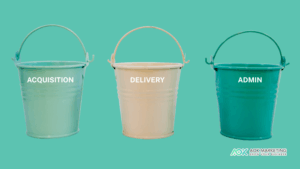Over the past 20 years, I’ve worked with hundreds of companies—some dominating page one and driving conversions like crazy, others wondering why their “great rankings” weren’t moving the needle. One of the most overlooked issues I’ve seen is artificially inflated SEO rankings—vanity metrics that look good but fall apart under scrutiny.
So, if you’re seeing traffic but no leads, or you’re ranking but not converting, it might be time to take a hard look at what’s really going on behind the scenes.
The Inflated Rankings Checklist: Is Your SEO Built on Sand?
It’s easy to get excited when you see your site climbing the SERPs. But if those rankings aren’t translating into real results—leads, sales, engagement—you could be running on borrowed time.
Here’s how to tell if your SEO success is legit… or just a house of cards.
1. Backlink Quality Over Quantity
Backlinks still matter—a lot. But too many SEOs chase volume over value, and that’s where trouble starts.
I always start with a backlink audit. If you haven’t done this, use tools like Google Search Console, SEMrush, or Majestic. Then ask yourself:
– Are my links relevant and from trustworthy sites in my industry?
– Is the anchor text natural, or does it look like it was written by a keyword bot?
– Are any links coming from spammy directories, expired domains, or link farms?
Here’s the deal: Google’s algorithm can spot manipulation a mile away. One strong backlink from a credible, niche-relevant source is worth more than 100 junk links from random blogs.
Case in point:
When we worked with PacketLabs, a cybersecurity firm, they resisted the urge to “go big” with mass exposure. Instead, they focused on building quality, high-intent traffic through trusted, relevant sources. That’s how you build rankings that last.
2. Relevance: The Difference Between Ranking and Converting
I’ve seen this a lot—sites ranking well for keywords that have nothing to do with their core business. It’s SEO inflation at its worst.
Here’s a quick test:
– Are your top-ranking keywords actually aligned with what your business sells?
– Is your traffic converting—or are people bouncing because they’re in the wrong place?
If your business is selling local landscaping services in Toronto but you’re ranking for “best gardening gloves in Italy,” that’s not organic growth—it’s algorithmic noise.
Real-world example:
With GS1 US, we cut their cost-per-acquisition dramatically by ditching high-volume fluff and zeroing in on relevant, purchase-driven keywords. That’s how you get results that matter.
3. The Content Smell Test: Would You Read It?
This is my go-to move when auditing a site: I read the content out loud.
And 9 times out of 10, if it sounds awkward, robotic, or like it was written for an algorithm—it’s not going to last.
Watch out for:
– Keyword stuffing that makes no sense
– Thin, AI-spun articles that add zero value
– Pages created just to rank, not to help
If your content doesn’t serve the user, Google will eventually figure it out—especially with AI-powered algorithm updates like Helpful Content and BERT.
Take it from Britannica:
Their SEO turnaround came from rebuilding authority content—not hacks. They added value, wrote for real people, and gained over 178 million monthly pageviews. Real content. Real results.
4. User Behavior Never Lies
You can’t fake good user signals.
If your bounce rates are sky-high, your time-on-site is low, and no one’s converting, Google will take the hint—even if you rank well for now.
Here’s what I tell clients:
– Watch your bounce rate, avg. session duration, and conversion rate.
– If they’re tanking, your rankings may be artificial—or fragile.
– If they’re rising, your audience is finding what they need. That’s SEO gold.
With GS1 US, once we realigned the messaging, UX, and targeting, bounce rate dropped by 23% and session time doubled. No tricks—just better alignment between content and user intent.
The Bottom Line: Don’t Confuse Rankings with Results
I’ve seen sites fall off a cliff overnight after a Google update—because their rankings were propped up by manipulative tactics, irrelevant keywords, or thin content.
Artificial SEO growth is fragile. It looks impressive on a dashboard but delivers nothing in return. And when the algorithm tightens up (which it always does), you’re back at square one.
What Actually Works (And Won’t Get You Penalized)
Here’s the long-game strategy that’s worked time and time again for my clients—and for my own brands:
– ✔ Audit your backlinks monthly. Prioritize relevance, trust, and diversity.
– ✔ Refine your keyword strategy. Align it with your business goals—not just search volume.
– ✔ Improve content across the board. Write for people. Format for Google.
– ✔ Track user signals religiously. If people stay, Google will reward that.
– ✔ Serve your audience’s intent. Every page should answer a question, solve a problem, or help someone take the next step.
Final Thoughts (From Someone Who’s Been There)
SEO isn’t about tricking Google. It’s about earning trust—from both users and search engines.
The hard truth? Artificial rankings are seductive. They make you feel like you’re winning, but they vanish when it counts most.
If you want SEO to be your most powerful acquisition engine, you need to commit to relevance, quality, and real value. Build it right, and the rankings (and results) will follow—and stay.
Thanks for reading. If you got value from this, share it with someone who needs to hear the truth about SEO inflation. Or better yet—start that backlink audit today.
About The Author
Dave Burnett
I help people make more money online.
Over the years I’ve had lots of fun working with thousands of brands and helping them distribute millions of promotional products and implement multinational rewards and incentive programs.
Now I’m helping great marketers turn their products and services into sustainable online businesses.
How can I help you?





